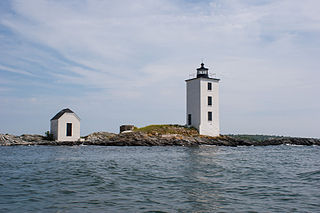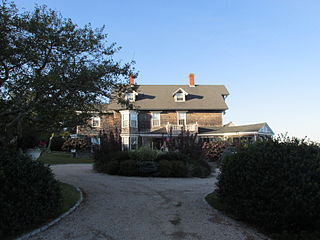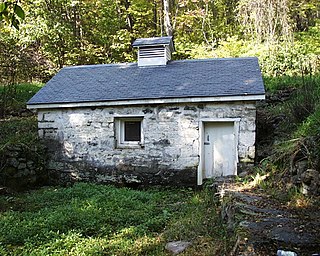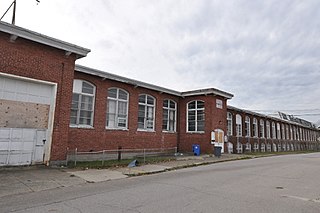
Narragansett is a town in Washington County, Rhode Island, United States. The population was 14,532 at the 2020 census. However, during the summer months the town's population more than doubles to near 34,000. The town of Narragansett occupies a narrow strip of land running along the eastern bank of the Pettaquamscutt River to the shore of Narragansett Bay. It was separated from South Kingstown in 1888 and incorporated as a town in 1901.

Peace Dale is a village in the town of South Kingstown, Rhode Island. Together with the village of Wakefield, it is treated by the U.S. Census as a component of the census-designated place identified as Wakefield-Peacedale, Rhode Island.

Fort Wetherill is a former coast artillery fort that occupies the southern portion of the eastern tip of Conanicut Island in Jamestown, Rhode Island. It sits atop high granite cliffs, overlooking the entrance to Narragansett Bay. Fort Dumpling from the American Revolutionary War occupied the site until it was built over by Fort Wetherill. Wetherill was deactivated and turned over to the State of Rhode Island after World War II and is now operated as Fort Wetherill State Park, a 51-acre (210,000 m2) reservation managed by the Rhode Island Department of Environmental Management.

The Wanton–Lyman–Hazard House is the oldest house in Newport, Rhode Island, built around 1697. It is also one of the oldest houses in the state. It is located at the corner of Broadway and Stone Street, in the downtown section of the city in the Newport Historic District. The house "was damaged by Stamp Act riots in 1765 when occupied by a Tory Stampmaster."

Dutch Island Light is a historic lighthouse on Dutch Island off Jamestown, Rhode Island.

The Captain Stephen Olney House is a historic site in North Providence, Rhode Island. It is a 2+1⁄2-story wood-frame structure, five bays wide, with a pair of interior chimneys. The principal exterior decoration is in the front door surround, which features pilasters supporting an entablature and gable pediment. The house was built in 1802 by Stephen Olney, a veteran of the American Revolutionary War, on what was then a large farm. His descendants enlarged the house in the 1840s, adding an ell to the south.

The Reservoir Avenue Sewage Pumping Station is an historic wastewater pumping facility on the south side of the junction of Reservoir and Pontiac Avenues in southern Providence, Rhode Island. From the street it looks like a single-story brick structure with a hip roof, and metal doorways on its north and east elevations. This building stands atop a substantial concrete substructure, which houses a dry well and wet well. The dry well, on the eastern side, houses the pumps, while the wet well, occupies the western two-thirds of the facility. The floor of the interior includes glass blocks for viewing the facilities below, as well as metal trapdoors for accessing the pumps. Manual gate valves on the west side are used to control sewage flow through the west well. This facility is used to pump raw sewage eastward and uphill to a gravity conduit in Rutherglen Avenue. This conduit carries the sewage to the Field's Point treatment facility. The pumping station was built by the city of Providence in 1931, and is now owned by the Narragansett Bay Commission, which operates the region's wastewater treatment facilities.

The Sludge Press House was an historic wastewater treatment facility building at the Fields Point Sewage Treatment Plant at Fields Point, Rhode Island in Providence, Rhode Island. It was a two-story brick structure, located near the center of the Field's Point facility, just east of the Chemical Building. It was about 138 by 51 feet in size, with a hip roof, and was built 1899-1901 as part of Providence's first wastewater treatment system. It housed the facilities used at the end of the treatment process by which remaining solids were dewatered and compressed before final disposal.

The South Street Station is an historic electrical power generation station at 360 Eddy Street in Providence, Rhode Island. The structure has since been redeveloped and is now used as an administrative office and academic facility by a number of local universities.

Druidsdream is a historic house at 144 Gibson Avenue in Narragansett, Rhode Island. It is a 2+1⁄2-story stone structure, completed in 1884. It was built, probably by predominantly Narragansett stonemasons, for Joseph Hazard, a locally prominent landowner and botanist. It has a cross gable plan, with its main facade divided into three bays, looking south over landscaped grounds. The central bay has a slightly projecting pavilion, with the second floor bays filled with French doors and iron railings.

Fort Ninigret is a historic fort and trading post site at Fort Neck Road in Charlestown, Rhode Island, built and occupied by European settlers in the seventeenth century. At its 1883 dedication, Commissioner George Carmichael, Jr. referred to it as "the oldest military post on the Atlantic coast."

Gardencourt is an historic home at 10 Gibson Avenue in Narragansett, Rhode Island.

The Ocean Road Historic District is a residential historic district, encompassing an area of fashionable summer houses built in the late 19th and early 20th centuries in Narragansett, Rhode Island. The area is located south of The Towers, the center of the Narragansett Pier area, extending along Ocean Road roughly from Hazard Street to Wildfield Farm Road. Many of the 45 houses in the district were built between about 1880 and 1900, with a few built earlier and later. The Shingle style is prominent in the architectural styles found, including among houses designed by architects, including McKim, Mead & White and William Gibbons Preston. The most unusual property is called Hazard's Castle, a rambling stone structure built beginning in the 1840s by Joseph Peace Hazard, who was a major landowner in the area prior to its development in the 1880s.

Keystone Mineral Springs is an historic mineral water bottling facility on Keystone Spring Road in Poland, Maine. Located along the former right-of-way of Keystone Spring Road in eastern Poland, the facility consists of two structures, a spring house built c. 1885 and a bottling house built in 1929. The facilities are, along with the more well-known Poland Spring Bottling Plant and Spring House, the only known surviving elements of the early period of mineral water bottling in Maine. The property was listed on the National Register of Historic Places in 2005.

Cold Spring Farm Springhouse is a historic springhouse located in Delaware Water Gap National Recreation Area at Middle Smithfield Township, Monroe County, Pennsylvania. It was built in the late-19th century and is a one-story, rectangular fieldstone building. It measures approximately 12 by 24 feet. It has a wood shingle roof and small cupola. Also on the property is a concrete dam, built about 1909. It represents a typical springhouse of the Delaware River Valley.

The Highland Spring Brewery Bottling and Storage Buildings, including the Oliver Ditson Company Building, are located at 154-166 Terrace St. in the Mission Hill neighborhood of Boston, Massachusetts. This complex consists of several brick industrial buildings. constructed over time beginning in 1892. The main building, a four-story Romanesque structure at 164 Terrace Street, was built that year by the Highland Spring Brewery. A second, five-story Georgian Revival building was added in 1912; this building was acquired in 1925 by the Oliver Ditson Company, a leading 19th century publisher of sheet music.

The American Brewing Company Plant, owned by the American Brewing Company, is a historic brewery complex at 431 Harris Avenue in Providence, Rhode Island that operated between 1892 and 1922. It is a well-preserved example of a state of the art late 19th century brewery building, its original functions still discernible in its layout. It was only used as a brewery until 1922, when it was shut down by Prohibition; it has served as a warehouse and storage facility for most of the time since. The complex was listed on the National Register of Historic Places in 2016.

The Naushon Company Plant is a historic textile mill complex at 32 Meeting Street in Cumberland, Rhode Island. First built in 1902-04 and enlarged over time, it illustrates the adaption of the site to differing uses between then and the 1950s, when its use for textile manufacture ended. The complex was listed on the National Register of Historic Places in 1978.

Frederick Clayton Olney was an American lawyer and entrepreneur. An African-American resident of Wakefield, Rhode Island, with Native American ancestry, he was one of the first African-American lawyers admitted to the bar in the state, and one of the founders of the Gladstone Springs Water Company.






















